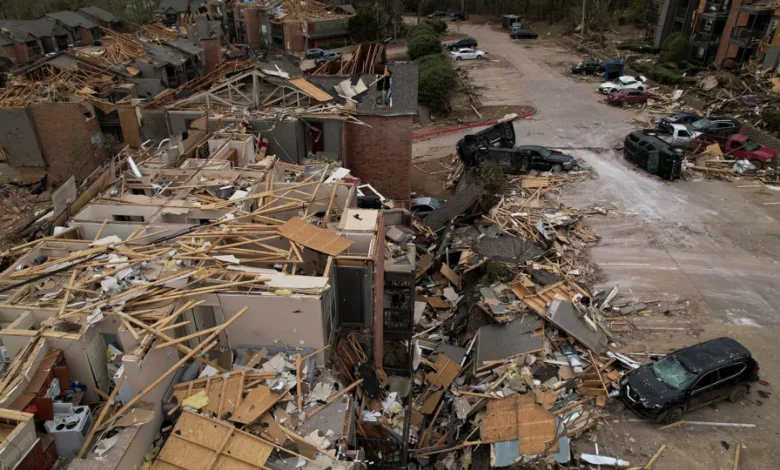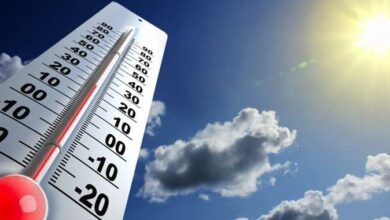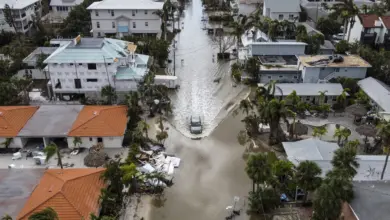
Nearly 70 million people from Texas to Michigan are under risk of severe weather Tuesday as another powerful storm system takes aim, threatening to batter states still reeling from deadly tornadoes.
There is a potential for strong, long-track tornadoes across a swath of the central US in the afternoon and particularly dangerous nighttime tornadoes could form in parts of Arkansas, Oklahoma and southern Missouri in the overnight hours.
There are two Level 4 of 5 moderate risk areas highlighted by the Storm Prediction Center Tuesday. The first stretches across eastern Iowa, northwestern Illinois and northeastern Missouri. The second includes southern Missouri and parts of Arkansas and Oklahoma.
Cities in the moderate risk areas include Springfield, Missouri, and Cedar Rapids, Davenport and Waterloo in Iowa.
A Level 3 of 5 enhanced risk area surrounds the moderate risk areas and includes St. Louis, Madison, Wisconsin; Des Moines, Iowa; and Little Rock, Arkansas, which was ravaged by a violent tornado Friday.
The forecast of severe weather comes after tornado-spawning storms over the weekend left 32 dead and dozens of others injured in the Midwest and South as at least 50 confirmed tornadoes touched down across several states, ripping homes apart as they barreled through.
“Many of the areas that got hammered by the last severe weather outlook could be at risk again, so it’s imperative that everyone in this region closely monitor the latest local forecasts and be prepared to take cover if warnings are issued,” the Weather Prediction Center warned.
The storms are expected to come in waves Tuesday, with multiple rounds especially likely across Iowa, Illinois and Missouri. The first round, expected in the afternoon, will bring the threat of very large to giant hail – possibly bigger than a baseball – the storm center said.
In west-central Iowa, there is potential in the afternoon for strong tornadoes, large hail and damaging winds.
“Additional (storms) may develop later (Tuesday) in association with the cold front and move into the region, posing a threat of hail and damaging gusts. A conditional tornado threat will also persist overnight with any sustained supercells,” the storm center added.
And storms are expected to develop overnight across southern Missouri and parts of Arkansas, bringing the possibility of “nocturnal strong tornadoes,” the storm center said. Tornadoes that occur in the overnight hours are more likely to be deadly than those that happen during the daytime, studies show, because people are less likely to receive weather alerts when they are asleep.
“Please remain weather aware, have multiple ways to receive warnings & stay tuned to the forecast for updates,” Missouri State Emergency Management officials warned.
Extremely critical fire threat in the plains
While some states face the threat of tornadoes and hail, about 10 million people from southeastern Arizona to southwestern Iowa are under red flag warnings Tuesday, with some local National Weather Service offices expecting “extreme grassland fire danger,” and calling it a “potentially dangerous situation.”
“Any fires that develop will likely spread rapidly and become very difficult to control,” the weather service said.
There is an “extremely critical,” Level 3 of 3 fire weather risk across portions of eastern New Mexico, western Texas, western Oklahoma and southern Kansas. This area includes Lubbock, Amarillo and Midland in Texas, Woodward in Oklahoma, and Liberal and Hutchinson in Kansas.
“Dangerous fire weather conditions are expected on Tuesday with potential for multiple large, dangerous, and fast moving fires,” the storm center warned. “Extreme caution should be used to avoid sparks and open flames.”
Ongoing severe to exceptional drought conditions, single digit relative humidity values, sustained winds of 35 to 40 mph, and very dry fuels have all combined to make these extreme conditions.
A larger Level 2 “critical” risk encompasses the Level 3 area and extends from the Texas-Mexico border to southern Nebraska, including Oklahoma City and Norman in Oklahoma, Wichita in Kansas, and El Paso, Abilene and Wichita Falls in Texas.
CNN Meteorologist Robert Shackelford contributed to this report.




